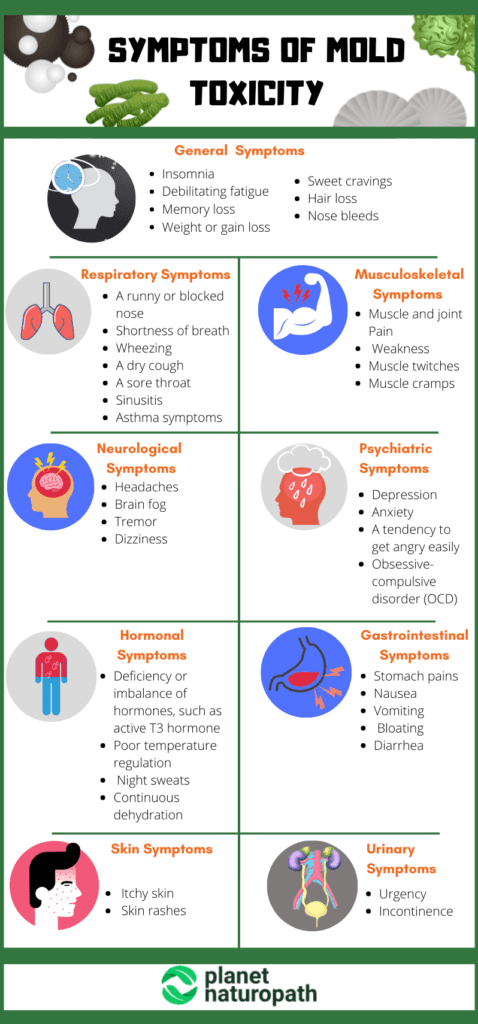In this article, we will explore the topic of whether nausea is a symptom of mold exposure and delve into the potential connection to gastrointestinal distress. We will discuss the possible causes of nausea when exposed to mold, the impact it can have on your overall health, and provide useful tips on how to prevent mold growth in your home. By the end of this article, you will have a better understanding of the relationship between mold exposure and nausea, allowing you to take necessary precautions to protect yourself and your loved ones.

Understanding Mold Exposure
Mold is a type of fungus that grows in moist and damp environments. It can be found both indoors and outdoors, and it thrives in areas with excessive moisture, such as bathrooms, basements, and kitchens. Mold reproduces by releasing spores into the air, which can then settle on surfaces and begin to grow.
Exposure to mold can occur in various ways. Inhalation is the most common route of exposure, as mold spores can become airborne and be easily inhaled. Additionally, direct contact with moldy surfaces or objects can also lead to exposure. It is important to note that certain individuals may be more sensitive to mold than others, and their reactions can vary.
When it comes to mold exposure, symptoms can manifest in different ways. Some people may experience respiratory symptoms, while others may notice skin irritations or allergic reactions. However, one symptom that often goes unnoticed is gastrointestinal distress, specifically nausea.
Symptoms of Mold Exposure
-
Respiratory symptoms: These can include coughing, wheezing, shortness of breath, and chest tightness. These symptoms occur because mold spores can irritate the respiratory system, causing an allergic reaction or triggering asthma attacks.
-
Skin symptoms: Mold exposure can also lead to skin irritations, such as redness, itchiness, and rashes. Direct contact with mold or moldy surfaces can cause these reactions, especially in individuals with sensitive skin.
-
Allergic reactions: Mold is a common allergen, and exposure to it can lead to allergic reactions. These reactions can range from sneezing, runny nose, and itchy eyes to more severe symptoms like hives and difficulty breathing.
-
Gastrointestinal distress: Nausea, vomiting, and diarrhea are often overlooked symptoms of mold exposure. While they may be dismissed as unrelated to mold, research suggests there is a connection between mold exposure and gastrointestinal issues.
Understanding how mold exposure affects the gastrointestinal system can help unravel this connection and shed light on the potential underlying causes of nausea.
Unraveling the Connection to Gastrointestinal Distress
Mold exposure can impact the gastrointestinal system in several ways. When mold spores are inhaled or ingested, they can irritate the lining of the stomach and intestines, leading to inflammation. This inflammation can disrupt the normal functioning of the gastrointestinal system, resulting in symptoms such as nausea.
Nausea is characterized by a sensation of queasiness and the urge to vomit. It can be triggered by various factors, including exposure to toxins and irritants like mold. When mold spores enter the body, they can release mycotoxins, which are toxic substances produced by certain types of mold. These mycotoxins can have a direct effect on the gastrointestinal system, leading to nausea and other related symptoms.
In addition to nausea, mold exposure can also cause other gastrointestinal symptoms, such as abdominal pain, bloating, and changes in bowel movements. These symptoms can mimic those of other digestive disorders, making it important to consider mold exposure as a potential cause when evaluating gastrointestinal distress.
Research and Studies
Several scientific studies have been conducted to explore the link between mold exposure and gastrointestinal distress. These studies have provided valuable insights into the potential effects of mold on the gastrointestinal system.
For example, a study published in the Journal of Occupational and Environmental Medicine found that individuals exposed to mold in their workplace had a higher prevalence of gastrointestinal symptoms, including nausea and diarrhea. Another study conducted by the National Institute for Occupational Safety and Health (NIOSH) reported similar findings among residents in water-damaged buildings.
Additionally, case studies and patient experiences have also highlighted the connection between mold exposure and gastrointestinal distress. Many individuals have reported experiencing nausea and other digestive symptoms after being exposed to mold in their homes or workplaces.
While more research is needed to fully understand the mechanisms behind this connection, these studies suggest that mold exposure can indeed contribute to gastrointestinal distress.

Diagnosing Mold Exposure-Related Gastrointestinal Distress
If you experience persistent gastrointestinal symptoms, it is important to seek medical guidance for a proper diagnosis. An evaluation by a healthcare provider can help determine if mold exposure is the underlying cause of your distress.
During a medical consultation, your doctor may inquire about potential exposure to mold and conduct a thorough physical examination. They may also recommend diagnostic tests, such as blood tests or allergy testing, to assess your body’s response to mold.
In some cases, additional tests or procedures may be necessary, such as imaging studies or endoscopy, to evaluate the extent of gastrointestinal inflammation or damage.
Treatment and Management of Mold-Related Gastrointestinal Distress
Addressing mold exposure is crucial in the treatment and management of gastrointestinal distress. If you suspect mold in your environment, it is important to identify and eliminate the sources of mold. This may involve fixing leaks, improving ventilation, and removing mold-infested materials.
When it comes to managing nausea and other gastrointestinal symptoms, medications may be prescribed to alleviate discomfort. Antiemetics, which are medications that reduce nausea and vomiting, can be effective in providing relief. Additionally, dietary modifications and lifestyle changes may be recommended to support overall gastrointestinal health.
To improve gastrointestinal health, it is essential to consume a nutritious diet, stay hydrated, and practice stress management techniques. Probiotics, which are beneficial bacteria that promote gut health, may also be recommended to restore the balance of gut flora.

Prevention and Control of Mold
Prevention is key when it comes to mold exposure. By taking appropriate measures, you can minimize the risk of mold growth in your surroundings. Here are some preventive strategies:
-
Identifying and eliminating mold sources: Regularly inspect your home and workplace for signs of mold, such as musty odors or visible growth. If mold is present, promptly address the issue by fixing leaks, drying wet areas, and removing affected materials.
-
Maintaining proper ventilation and humidity levels: Ensure proper ventilation in your living and working spaces to reduce moisture accumulation. Use exhaust fans in bathrooms and kitchens, and open windows to allow fresh air circulation. Additionally, use dehumidifiers to control humidity levels, especially in areas prone to dampness.
-
Regular cleaning and maintenance: Clean and dry any water spills or damp areas promptly. Regularly clean and disinfect areas prone to mold growth, such as bathrooms and basements. Pay attention to indoor plants, as excessive moisture in the soil can promote mold growth.
Potential Health Risks and Complications
Prolonged mold exposure can have various health risks and complications, particularly for individuals with underlying conditions and vulnerability. The severity of these risks can vary depending on factors such as the type and amount of mold, duration of exposure, and individual susceptibility.
In addition to gastrointestinal distress, prolonged mold exposure can worsen existing respiratory conditions, trigger asthma attacks, and contribute to chronic sinus infections. It can also lead to allergic reactions and skin infections in sensitive individuals.
Furthermore, long-term gastrointestinal effects may include the development of conditions such as irritable bowel syndrome (IBS) or gastrointestinal inflammation. These conditions may require long-term management and can significantly impact an individual’s quality of life.

Seeking Professional Help
If you are experiencing persistent gastrointestinal symptoms or suspect mold exposure, it is essential to consult a doctor or specialist. They can help determine the cause of your symptoms and provide appropriate treatment options or referrals.
When seeking medical help, it is important to choose the right healthcare provider. Look for specialists who have experience in environmental medicine or allergies, as they are likely to have expertise in identifying and managing mold-related health issues.
Conclusion
In conclusion, nausea can indeed be a symptom of mold exposure and is part of a larger spectrum of gastrointestinal distress. Understanding the link between mold exposure and gastrointestinal symptoms is essential for early detection, proper diagnosis, and effective management.
Prevention is key when it comes to mold exposure. By maintaining a clean and dry environment, improving ventilation, and promptly addressing any signs of mold, you can reduce the risk of mold-related health issues.
If you experience persistent nausea or other gastrointestinal symptoms, it is important to seek medical guidance. A healthcare provider can help determine the underlying cause and provide appropriate treatment and management strategies to promote overall well-being and healthy living.
